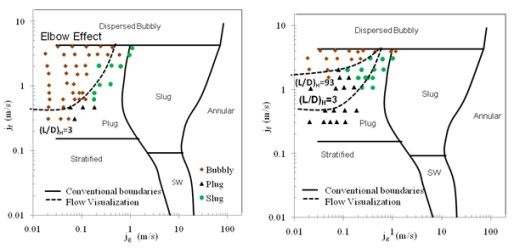Two-Phase Flow in Combinatorial Flow Channels
Research Supported by the US NRC and by the US DOE NEER Program
Most energy systems, including nuclear reactors, have flow channels in varying configurations that are interconnected via various flow restrictions such as elbows, valves, and tees, etc. The presence of the flow restrictions induces significant changes in the interfacial structures, their transport characteristics, and flow regime transition. This in turn affects the mass, momentum, and energy transfer in a two-phase flow system, and hence the safety and efficiency. Experimental studies are crucial in improving the understanding of the effect of flow restrictions on two-phase flow and developing dynamic models for transport of interfacial area.

This project is focused on investigating the geometric effects of 90-degree vertical elbows and combinatorial flow configuration on two-phase flow. The experimental facility consists of vertical and horizontal sections made out of 50.8 mm inner diameter acrylic pipes interconnected via 90-degree vertical glass elbows. The maximum development length in the vertical and horizontal section is 66D and 180D respectively. A total of 24 measurement locations are present along the test section. A set of two injectors and manipulating valves allows the two-phase flow to be started in either vertical-upward or vertical-downward flow configurations. This flow loop is capable of simulating different flow configurations such as co-current or countercurrent flow.
A high speed camera is employed to perform flow visualization studies across the first 90-degree vertical elbow. Based on extensive flow visualization studies modified horizontal two-phase flow regime maps are suggested at two locations downstream of the vertical elbow as shown in Figure 2.

The four-sensor conductivity probe is used to obtain extensive local data in vertical as well as horizontal section. The measured parameters include: void fraction, bubble velocity, interfacial area concentration, bubble frequency and bubble Sauter mean diameter. Figure 3 shows the development of the three-dimensional measured local void fraction across the elbow. Interesting results are obtained in the horizontal section immediately downstream of the vertical elbow wherein the local void fraction has a dual peaked profile along the horizontal axis of the pipe cross-section. It is speculated that the secondary flow generated by the elbow entrains smaller bubbles causing them to be distributed in two distinct regions of the pipe cross-section.
